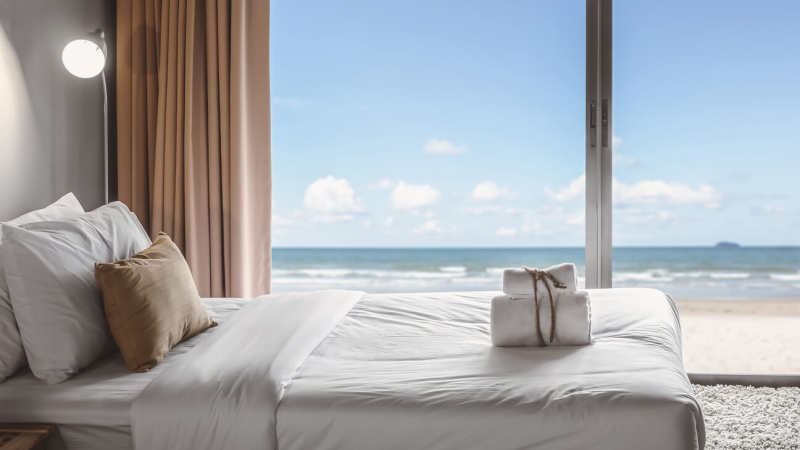From roadside motel rooms to presidential casino suites, there are a plethora of different types of hotel rooms for the modern traveler to choose from. Whether you’re booking at a large brand or chain hotel, a boutique hotel, an all-inclusive resort, or another accommodation style, there’s a room type out there to fit everyone’s unique needs.
In this guide, we take a deep dive into some of the most popular types of hotel rooms and what they include. We break down room types based on size, style, and services, and then answer some frequently asked questions about hotel room types.
All of the different types of hotel rooms you need to know
Once upon a time, hotels, roadside inns, and other overnight accommodations provided weary travelers the most basic of offerings: A place to sleep, sheltered from the elements, in exchange for money or services. Over the ages, hotels have evolved to meet a wide array of different personal preferences and traveler needs. Extended stay business travelers are typically looking for a different room type than a family of five on vacation, for example, and the industry has grown to accommodate varying needs.
Modern hotels provide a variety of services, meet many different price points, and provide a large selection of room types for guests to choose from. The different types of hotel rooms available at a property are commonly influenced by a myriad of factors. For example:
- Is the hotel independently owned or part of a brand?
- Is it a motel, hotel, inn, or resort?
- Is the property all-inclusive or all-suites?
- Is the property limited-service or full-service?
Hotel room types vary in terms of size, style, layout, in-room amenities offered, and other factors. They can range from the small, affordable economy rooms found off the side of many highways to spacious suites that boast thousands of square feet and carry vastly different price tags. In addition, some hotel rooms are designed specifically to be more accessible for guests who benefit from additional assistance.
Let us help you maximize your hotel industry knowledge
Finding the type of hotel room you want
Travelers looking for a specific type of hotel room — such as an ADA accessible room, a pet-friendly double-double room with a pullout couch, or even a first-floor smoking room — can typically find what they’re looking for through a quick online search. Most hotels include a list of their room types on their hotel website, social media pages, and OTA booking sites.
Online room type descriptions usually include a list of hotel amenities, sleeping arrangement details, room size, and hotel policies. Search for hotel room types based on the number of guests that the room accommodates, the bed size you’re looking for, available in-room amenities, or other details that will help you quickly identify potential hotels to book with.
Occupancy-based hotel room types
One of the easiest ways to differentiate between the different types of hotel rooms is to search for rooms based on occupancy. Many room type descriptions include the number of guests the room is meant to accommodate in the title: single, double, triple, quadruple, and so on. The majority of hotels list the bed size in the name of the room type so it’s easy to identify online.
A single room is intended to sleep one person and most likely has one king or queen bed in the room. Double rooms, sometimes called double-double rooms, have two separate beds. While some double rooms have two full-sized beds, others may have queens or kings. A triple room could refer to a room with two smaller beds and a pull-out sofa, or a king bed and a pullout. In other words: It varies from property to property.
Types of hotel room layouts
1. Room-only hotel rooms. Some overnight accommodations include only a room: Dorm-style hotels, some inns, bed and breakfasts, and some hostels. In these hotels, the bathroom, kitchen area, and other living spaces may be shared by multiple guests; rental includes a private room only.
2. Standard hotel rooms. Most standard hotel rooms, such as the types you would encounter at motels or many brand hotels, offer a room and separate bathroom area for travelers to book nightly. These rooms are usually marketed by the type of sleeping arrangements available: King room, queen room, or double room. While the layout of the room may vary in terms of additional furniture, whether the bathroom includes a shower/tub combination or a shower only, as well as included amenities, you can, at minimum, expect to find a bedroom and a bathroom in a standard hotel room.
3. Minimalist hotel rooms. Some hotel chains are launching brands with minimalistic hotel room styles, such as Tru by Hilton. Designed with tech-savvy, budget-conscious travelers in mind, these hotels put more focus on the property’s communal spaces: The lobby, breakfast area, and outdoor areas, for example. While the rooms may still offer a separate bedroom and bathroom, they're typically smaller than standard hotel rooms and are designed to accommodate guests that don’t intend to spend a lot of time in their room. With wall hooks instead of a closet, for example, or a multi-functional chair instead of a separate desk, these rooms maximize storage with clever design tricks.
Explore our massive library of hotel resources
4. Deluxe hotel rooms. Size and price are usually the two main differences between standard and deluxe hotel rooms. Deluxe rooms are usually larger than their standard counterparts, may include a bathtub and a shower in the bathroom, and include more high-end amenities. Many deluxe hotel rooms are also advertised based on the view they offer guests: Bay view, city view, mountain view, or other desirable scenery for travelers to enjoy. Some include patios, balconies, a private terrace, or other additions that set them apart from standard room types.
5. Studio hotel rooms. Studio-style hotel rooms offer living, sleeping, and often dining space all in one room. Some studio hotel rooms include a bed while others include a pull-out sofa that doubles as both the living and sleeping furniture. While the bathroom is usually private, or at least separated from the rest of the room, the rest of the room is typically an open space that accommodates all traveler activities. Studios may include small kitchen areas as well.
6. Connecting rooms. Connecting rooms lie side by side on a hotel floor. While connecting rooms have separate outside entrances, they're also connected inside via a set of two doors. Each room has access to one door and the freedom to unlock it. When both doors are unlocked, the two rooms can be turned into one large space. Connecting rooms are commonly found in large brand hotels and are popular choices for a variety of group blocks, such as large families, youth sports teams, wedding party members, and other travelers looking for access to more space.
7. Suites. Like studio rooms, hotel suites usually boast more than just a bed and a bathroom. Unlike studios, however, suites are typically defined by their separated spaces. The bedroom is often separated from the living space by a wall, sometimes with a privacy door. The living room may include a pull-out sofa to accommodate additional guests as well. Suites also tend to include a separate kitchen area with appliances, dining space, and the ability to store food. Not all suites include full kitchens, however, many only include kitchenettes — a scaled-down functional kitchen space.
Hotel suite styles
While suites offer larger, more separate spaces than a standard hotel room, there are many different suite styles for travelers to choose from. We’ve picked some of the most popular suite options to outline and highlight in the list below.
1. Standard suite rooms. In comparison to most hotel rooms, standard suite rooms tend to be larger than their more basic counterparts. Whereas standard hotel rooms are typically separated into two main areas (bedroom & bathroom), standard suites usually include a separate living space.
2. Junior suites. These are typically smaller versions of standard suites. While the layout likely denotes a specific space intended for sleeping, as well as a designated living area, the two may not be physically separated by a barrier. In junior suites, the living space may be a smaller extension of the bedroom area that doesn't come with a separate dining space. But again, it varies from property to property.
3. Presidential suites. Of all the different suite types, presidential suites are known for being some of the most impressive. If a hotel offers this suite type, there are usually only one or two available in the entire hotel — even with the largest brands. Presidential suites are some of the most expensive hotel rooms available for travelers to book on the entire market. Rates for the presidential suite at the Four Seasons Seattle, for example, begin around $6,500 a night.
4. Penthouse suites. Penthouse suites are usually located on the top floor of a luxury building and can take up the entire floor. Hotels that offer these accommodations are often found in the heart of iconic cities. Many casinos, luxury hotels, and exclusive resorts offer these suites to their most valued guests. For guest privacy, a hotel may require a card or key to be entered into the elevator to even access the penthouse floor.
5. Honeymoon suites. Designed with couples in mind, honeymoon suites are also known as romance suites. Honeymoon suites usually offer amenities, services, and special accommodations related to romance. Guests may arrive to find champagne, roses, chocolates, and fresh flowers in their room. Many newlyweds book honeymoon suites as part of a vacation or honeymoon travel package, coupled with excursions, activities, and private dining add-ons.
6. Bridal suites. Hotels that specialize in wedding services and accommodation often offer bridal suites to help the bridal party prepare for the big day. Typically large, open rooms with flexible work areas, many soon-to-be-weds use this space to get their makeup and hair done, get dressed, and celebrate with the bridal party.
Accessible hotel rooms and other special accommodations
In addition to size, occupancy, and layout, hotel rooms may also differ based on their accessibility or special accommodations. Accessible room types are designed to meet ADA guidelines and provide guests with accessibility needs and additional assistance while in their room.
Lower countertops and beds, wider travel paths, and accessible bathroom accommodations are some of the modifications that can be found in accessible rooms. Hearing or vision accessible rooms can be equipped with different phone systems, fire alarms (light vs. sound), or alarm clocks, for example.
Some hotel rooms are popular based on special accommodations or policies offered. Casinos, resorts, and many standard hotels still offer smoking accommodations, though often limited in quantity. Hotel room types may also be distinguished by their pet-friendly status.
While pet-friendly hotels are winning over new customers, not all hotels accommodate four-legged travelers. A hotel may be entirely pet-friendly, have a few rooms designated as pet-friendly, or only allow service animals. The fees and pet policies can vary drastically from one hotel to the next. Always double-check the pet status and policies associated with your specific room type.
Other types of hotel rooms
Some travelers are seeking less traditional overnight accomodations and opting instead for a more unique hotel experience. Depending on the destination, the season, the climate, and personal preferences, travelers may opt to book non-traditional overnight hotel room types, such as:
- Apartments/condos
- Guest suite/mother-in-law suite
- Rented/private room or residence (Airbnb, VRBO)
- Villas
- Cabanas
- Bungalows
FAQs about types of hotel rooms
What are the different types of hotel rooms?
There are lots of different types of hotel rooms available for modern travelers to choose from. Some hotels offer standard king or double rooms only, whereas others offer all-suites or apartment-style living. While some hotel rooms are pet-friendly or allow smoking, others do not. Suite rooms tend to include a kitchen area, whereas standard rooms do not. There’s now a room type out there to fit just about every style, and new hotel room types are evolving all the time.
How many types of rooms are in a hotel?
The number of room type options available at a hotel depends on the type of hotel. Larger brand hotels may offer singles, doubles, and suites in the same property. All-suite hotels include suite rooms only, while casino hotels may offer everything from small economy rooms to the world’s most luxurious hotel suites. It all really depends on the type of hotel and the services they offer.
What types of hotel rooms are the biggest?
Suites are usually considered to be the largest style of hotel room available in most hotels. Suites usually offer multiple separated spaces: Bathroom, kitchen, bedroom, living area, and sometimes many more. Most suites offer apartment-style living and tend to feel much more like staying in a condo or apartment than a hotel room.
Now you know all about the different types of hotel rooms!
Up next, learn about the people who fill all of the different types of hotel rooms with our guide to 7 types of hotel guests.







